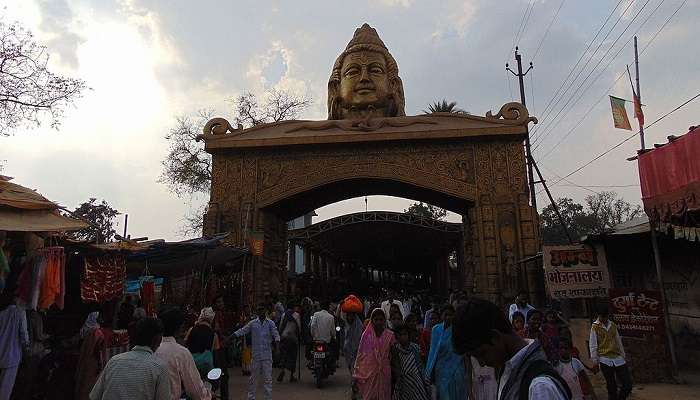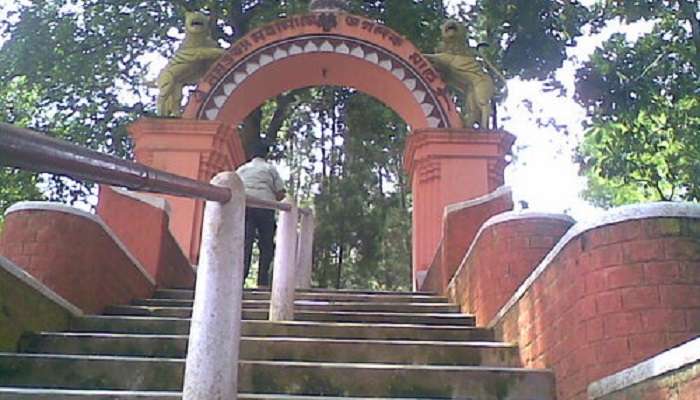Mahamaya Temple In Assam To Visit In 2026

Mahamaya Temple is located in Assam and is a revered spot for pilgrims, expecting a huge crowd annually. The temple is near the Dhubri town of Assam and poses as the second most important temple in the region, coming second to the Temple Kamakaya. Devi Mahamaya, or Goddess Mahayama, is the Hindu deity of illusion, and worshipping her is known to cure many ailments in LIfe. In addition, as Assam is filled with pilgrimage sites of all religions, the area near the temple remains crowded throughout the year. Thus, keep reading our blog to know more about the origin and present-day importance of Mahmaya Temple in Assam.
An Overview Of Mahamaya Temple

Mahamaya Devi Temple is a Shakti Peeth located in Assam. Shakti Peethas are places of extreme power, as per Hindu tradition, and they also bear a mythological significance. The temple is dedicated to Devi Mahamaya, who controls the world’s illusions. The deity is also worshipped with pomp and is shown during Durga Puja and other festivals.
During these festivals, the deity is showered with animal sacrifice as a part of a 400-year-old tradition. The priests and the pilgrims believe it to be an integral part of pleasing the goddess. The animals used include buffaloes, goats and birds. The temple also has another extension about 2 kilometres away, known as the Snaanghat Temple, which serves the purpose of being the centre of Shakti Yagya, an ancient tradition practised to date by the temple priests.
- Mahamaya Temple Location: Mahamaya Temple RdAlupara Pt.II, Assam 783349
Also Read: Temples In Assam
History Of Mahamaya Temple

Mahamaya Temple is one of the most important Shakti Peethas out of the 51 such places. According to Hindu mythology, Shakti Peethas are the areas where the body parts of Goddess Sati, the wife of the Hindu God Shiva, were scattered upon her death. The temple and the deity were initially worshipped by the local people of the Parvatjowar area, including the Natha, Kacharis, and Koches. These people had their traditions, and the goddess was worshipped along with the rules set in the community. Even the zamindar of Parvatjowar, the area’s landowner, bowed in front of the deity as the local guardian. It was much later than that that the goddess received widespread acceptance, and people came in to worship her.
Hence, the little tradition consisting of local traditions and rituals was transformed into a great tradition, which means that the deity gained prominence across the significant communities of the region. Moreover, during festivities like Durga Puja, the deity is adorned in garlands and other offerings and worshipped with grand celebration. In the month of Bahag, a Shakti yagya is performed, an annual event to commemorate the universal driving force of the universe, the Shakti.
Architecture of Mahamaya Devi Temple

Firstly, the deity is situated in the Garbagriha or the sanctum sanctorum, the farthest place from the temple’s gates. This place only houses the deity and is considered to bear the most spiritual reverence. Next comes the mandapa, which is the preceding halls of the temple that the devotees pass through to come closer to the garbagriha. These mandapas were divided into various segments based on the ancient rituals, and sometimes, there was a mandapa dedicated to dance, theatrics, and other performing arts.
In addition, the last part of the shikhara, or the tower-like structure of the temple, is primarily seen in the Nagara, Beshara, or Pahari style of temple architecture. At the same time, it remains absent in the southern Indian temples or the Dravida style. This temple does have a shikhara, making it a probable architectural style of either of the three styles, excluding the Southern Indian influence. Over the years, renovations would have made certain elements more prominent, which archaeologists can only determine through thorough analysis.
Related Post: Umananda Temple
How To Reach

Here are a few ways to reach Mahamaya Temple in Assam:
By Air
People can board aeroplanes and land in Guwahati, after which they can either book a taxi or use a public vehicle to get to Mahamaya Devi Temple. The nearest town to the temple is Kokrajhar, about four and a half hours away by road from Guwahati airport.
By Rail
The Mahamaya Temple Assam is in Kokrajhar town, three and a half hours away from the Guwahati Railway Station. So, people can hop on a train to the station and then use local transportation to get to the temple.
By Road
Once in Guwahati or at least in Assam, people who are fond of road travel can drive to the Mahamaya Temple. They can also use buses that usually travel all throughout the day, or book a taxi. There are locally run automobiles available as well.
You May Also Like To Read: Tourist Places in Assam
Conclusion
Mahamaya Temple remains a sacred site for huge pilgrimages and even greater devotion. The site has a tremendously rich history and mysterious power to change the lives of the devotees for good. After worshipping, people can also look around the scenic landscape of rivers and hilly terrains. Hence, if you want to pray to the Mother Goddess with all your heart and bask in spiritual bliss, book a trip to Assam now! Land at the Guwahati Airport and rush over to the Mahamaya Temple Assam with your family and friends.
For our editorial codes of conduct and copyright disclaimer, please click here.
Cover Image Credit : Deven2105 for Wikipedia
FAQs
Why is Mahamaya Temple Assam famous?
The Mahamaya Temple in Assam is famous for being one of the most sacred places of worship for Hindus. This temple is regarded as second to only the Kamakhya Temple and is also well-known for its unique architecture.
Is the Mahamaya Temple a Shakti Peetha?
Yes, the Mahamaya Temple is a Shakti Peetha in Assam. Shakti Peethas are sacred spots of divine energy in Hindu mythology, and Mahaymaya Temple or Dham happens to be one of the most prominent ones.
What is the Snaanghat Temple?
According to popular tales and folklore, the Snaanghat Temple used to be the bathing place of Goddess Mahamaya. With the prevalence of this ancient tale, the place now has become a popular site located near the main Mahamaya Temple.
What is the architectural style of Mahamaya Temple?
The architectural style of Mahamaya Temple is Nagara, which was prevalent in Northern India in ancient times. With this style, the temple bears three important features: the mandapas, shikhara and the garbagriha.
People Also Read:
Amareswara Temple Vijaya Vittala Temple Anantheshwara Temple

With a passion for exploring and travelling to the roads long forgotten, experience the world through enthralling stories and adventures. Join me as I share my experiences at some of the world’s most popular tourist destinations and quench that pestering curiosity with something exciting!











